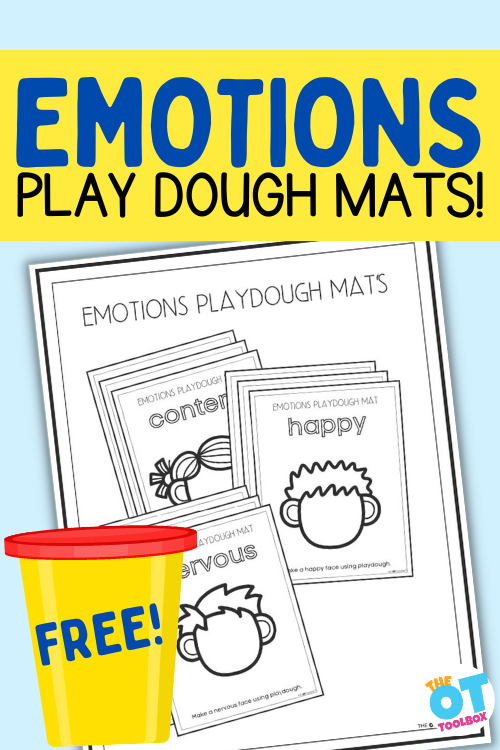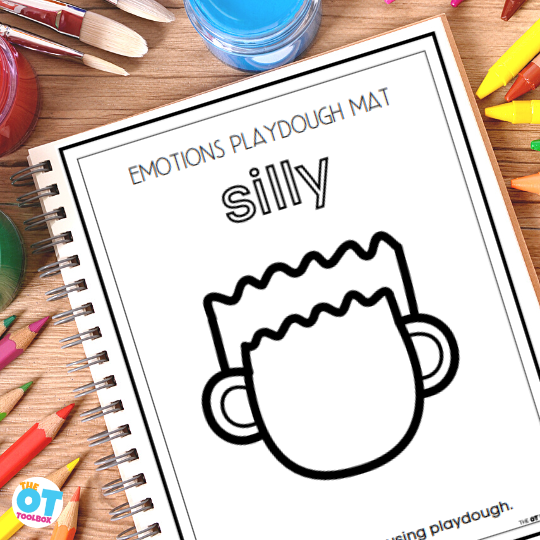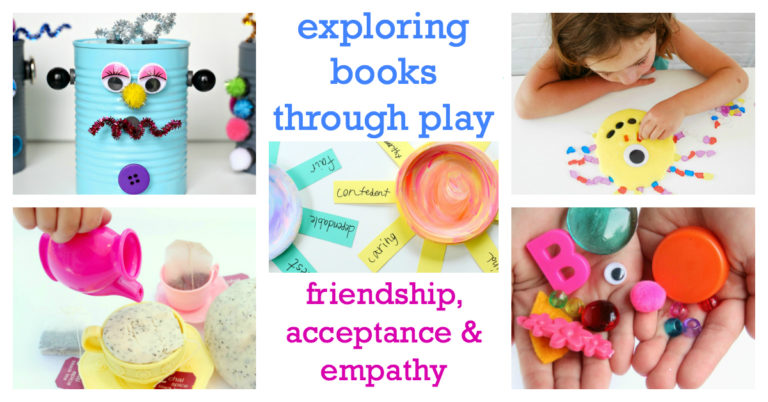One fun therapy tool to address social emotional learning in children are emotions playdough mats. Kids can use the printable play dough mats as tools to develop emotional awareness. understanding feelings, naming feelings, and practicing facial expressions. All of this occurs along with the many benefits of play dough! Let’s get some emotions play dough activities into your hands!

Emotions Playdough Mats
Facial expressions convey feelings and emotions. This is an important social and emotional skill for preschoolers. It’s through play and practice that young children explore different emotions. Using play as a tool to support that development makes sense!
Arlin Cuncic from Very Well Mind states, “If you only listen to what a person says and ignore what their face is telling you, then you really won’t get the whole story. Often, words do not match emotions, and the face betrays what a person is actually feeling”. You can read more about Understanding Emotions through Facial Expressions.
Early research stated we have seven universal facial expressions, however research from 2020 states we have closer to sixteen. Some expressions may last a long time, making them easier to read, however there are also micro expressions that are fleeting. A micro expression may be covering up a lie or concealing another emotion. The introduction of global mask wearing made reading facial expressions that much more difficult.
Many people have difficulty reading emotions or understanding them. Today’s freebie, the Emotions Playdough Mats is a great tool to teach and talk about feelings, facial expressions, and emotions.

Use Playdough mats to learn feelings
Some emotions such as anger, crying, and happiness are fairly easy to read, but what about the more difficult facial expressions such as disgust, disappointment, boredom, disinterest, or doubt?
Younger learners often say they are bored, when really they might be overwhelmed, frustrated, anxious, tired, scared, or a host of other emotions. Using tools like the emotions playdough mats is a non threatening activity to help learners understand these complicated feelings.
One way to support this development is by using a PDF play dough mat with a feelings theme. Toddlers, preschoolers, kindergarteners, and older children can use this strategy to practice different facial expressions while creating faces made from playdough.
People learn by doing, not just listening or watching someone else do it. The Emotions Play Dough Mats explore through play.
Play based therapy is at the heart of occupational therapy. The great thing about this activity is that it works on multiple skills whether in the classroom or therapy clinic.
- Playdoh is a great sensory medium – it addresses tactile, visual, olfactory, and proprioceptive input for little hands.
- The dough can be purchased or made at home. I found this cute website for sensory dough in dozens of different styles. If you prefer to make your own, you can find different playdough recipes here.
- Playdough is also great for strengthening the tiny hand muscles. Make your dough soft or stiff, or substitute with therapy putty for a more intense workout
- Working with playdough is a great fine motor activity. Folding, pinching, pulling apart, flattening, molding, cutting, and rolling are great fine motor skill builders
- Cutting playdough is a powerful fine motor activity! Add scissors and cut out the shapes you need.
How to Use Feelings Playdough mats
What are some other skills you can think of that can be incorporated into working on the emotions playdough mats while creating play dough faces?
- Print off the PDF files.
- Laminate them or you can slide the page into a page protector sleeve.
- Use play dough to create faces on the playdough mats based on the prompts.
Use the printable pdf file over and over again to support social emotional learning with children!
There are more ways to use these resources to address fine motor, sensory motor, visual motor, and of course social emotional skills:
- Use play dough to create facial features. Children can explore and identify nuances of facial features that are paired with emotions. These features might include furrowed eyebrows, frown lines around the cheeks, small eyes, etc. By using the playdough face mats, kids can create these features.
- How about social function? Following directions, turn taking, task completion, orienting to details, neatness, multi-tasking, attending to task, and impulse control can be addressed using the playdough emotions mat
- What about bilateral coordination? Using two hands together to create the playdough pieces, or one hand to hold the paper while the other hand works the playdough to create facial expressions, facial features, and emotions in the dough.
- Can you think of visual perceptual skills addressed with this activity? Parts to whole, copying from a model, creating a representation from a picture, visual memory and recall are just a few.
- Explore social skills- These emotion playdough mats are perfect addition to social skills interventions. Ask the child why a person may feel the way the facial expression is depicting. How can they support or help a person who feels that way? Have they ever felt that emotion or feeling? What did they do about it when they did feel that emotion? This feelings activity can go in so many different directions using a bit of follow-up questions and conversation while creating with the emotions playdough mats. Include a social skills checklist and you’ve got a strategy to support social emotional development in therapy sessions.
- Focus on fine motor strength by creating a small face from the play dough. Can you use a toothpick or a pencil point to poke a smile or frown into a ball of play dough? This can be another fun hands strengthening activity of its own!
We love to use play dough mats like this emotions mat to work on hand and finger strength. You can use the play dough fine motor exercises shown in the video below to support these skills. The video includes finger strength exercises.
How can you modify these playdough emotions mats? There are so many ways to extend this social emotional learning activity!
- Definitely think about laminating these to make them easier to use, more eco friendly, and less messy
- Cut out facial expressions from magazines to glue to the blank faces. Now you have added cutting and pasting to your task!
- Have your learners draw facial expressions instead of using playdough. Voila! A visual motor task has been born
- Create a smart board activity so learners can draw on the board, drag pieces, or work together
- Take pictures of their artwork and create a collage to keep
- Make this part of a larger lesson plan by adding gross motor, social, sensory, and other fine motor games
- Pre-cut pieces of facial expression for beginning learners to identify and glue
- Advanced learners can talk about the emotions, research them, write stories or situations about each face, and role play
- Use fine motor add-ons to improve dexterity and eye-hand coordination. Think: craft pom poms, sequins, googly eyes, pipe cleaners, etc. Use the materials to add to the various emotions on the free playdough mats.
- Emotions Monster I Spy page is a great resource to add to your lesson plan
- The Emotions Frog Slide Deck is another great tool
- Incorporate these social emotional learning worksheets for more fine motor work while exploring feelings with kids.
- The OT Toolbox also has a spring themed slide deck to add to your “toolbox”
While there are definitely people who can’t read facial expressions or body language, there are others who are too attuned to these. The Highly Sensitive Person is often hypersensitive to the emotions and facial expressions of others. They feel and notice much more than typical people. The HSP might be shy or cautious because they feel and see too much.
They may avoid eye contact because of the amount of information transmitted through the face. If you are highly sensitive you might find daily occurrences to be “too much”.
Too loud, bright, busy, chaotic, messy, overwhelming, smelly, sticky, and on and on. The irony of wearing masks, is that they have been great for those who are highly sensitive to facial expressions.
Whether your learners are highly sensitive, just learning about emotions, or having difficulty reading non verbal communication, the emotions playdough mat is a creative way to add fun into your treatment plan while working on important skill acquisition.
Free printable emotions playdough mats
Would you like a free printable playdough mats of your own to work on SEL with kids? Get a PDF version of these playdough mats to print off and use with your therapy caseload or in your classroom (or home)!
Enter your email address into the form below to access this printable resource. Or The OT Toolbox Member’s Club members can access this inside the membership on our social emotional toolbox.
Working on addressing feelings, emotions, acceptance, and empathy in kids? Use the hands-on activities selected to support these concepts in skills using popular children’s books as a theme. Grab Exploring Books Through Play: 50 Activities Based on Books About Friendship, Acceptance and Empathy today!

Victoria Wood, OTR/L is a contributor to The OT Toolbox and has been providing Occupational Therapy treatment in pediatrics for more than 25 years. She has practiced in hospital settings (inpatient, outpatient, NICU, PICU), school systems, and outpatient clinics in several states. She has treated hundreds of children with various sensory processing dysfunction in the areas of behavior, gross/fine motor skills, social skills and self-care. Ms. Wood has also been a featured speaker at seminars, webinars, and school staff development training. She is the author of Seeing your Home and Community with Sensory Eyes.







